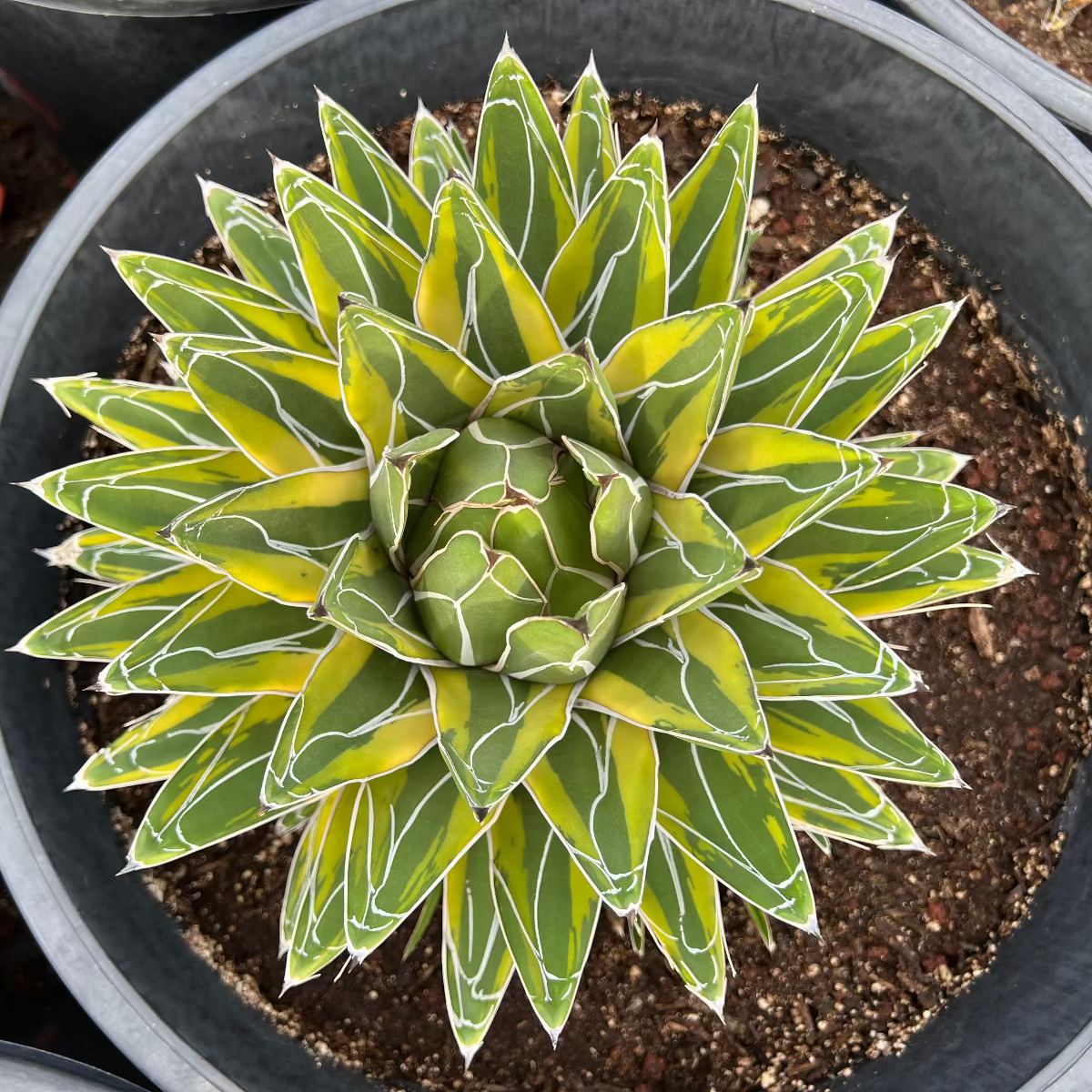My Store
Variegated Queen Victoria
Variegated Queen Victoria
Couldn't load pickup availability
Plant Type: perennial, succulent
Plant Height: 1–1.5 feet
Spread: 1.5–2 feet
Flower Color: cream to pale yellow (on tall stalk)
Sun Exposure: Full sun, Partial Shade
Variegated Queen Victoria / Agave victoriae-reginae variegata: Sculptural Elegance with Striking Contrast
The variegated form of Agave victoriae-reginae (Queen Victoria Agave variegata) is a compact and beautifully ornamented succulent with dark green leaves edged or patterned in creamy white variegation. This cultivar retains the crisp, geometric form of the species while introducing striking contrast and brightness. It performs admirably in desert and rock gardens, as a container specimen, or as part of a modern succulent composition, especially in Arizona’s harsh light.
Key Features of Variegated Queen Victoria
The rosette remains tight and symmetrical, with stiff lance-shaped leaves showing irregular cream or ivory margins or marbling against deep green centers. Leaf edges are typically smooth (no teeth), and each leaf ends in a sharp terminal spine. As with other Queen Victoria agaves, this plant is monocarpic—after many years it will produce a tall floral stalk bearing creamy-yellow blooms, then the main rosette will die, leaving behind offsets. The variegation remains stable under strong sun, especially when colors are accentuated by bright daylight and cool night temperatures.
Growing and Care Tips
This variegated agave thrives under full sun but benefits from partial afternoon shade in extremely hot conditions. It demands extremely well-draining, gritty or rocky soil to prevent moisture accumulation. During its first season, irrigate lightly and infrequently to encourage root development, then shift to a drought-mode regimen once established. Overwatering or poorly drained soil is its primary threat. Fertilizer is seldom needed—if used, a small dose of cactus/succulent formula in spring is sufficient. It tolerates minimal cold but does best when protected from extended freezing.
Landscaping Uses
Because of its compact size and visual contrast, this variegated Queen Victoria agave is perfect for accenting rock gardens, modern xeriscapes, and succulent displays. Use it as a focal specimen in gravel beds or raised planters, or cluster with other contrasting succulents to highlight its variegation. It also works beautifully in containers where its refined form can be appreciated up close.
Summary
Variegated Queen Victoria is the same striking, architectural agave as the species, but with the added dimension of creamy variegation that enhances its sculptural appeal. For gardeners seeking contrast, texture, and ease of care in arid settings, this cultivar is an elegant and resilient choice.
Three Timbers Installation Guide (Feel Free to Follow):
Variegated Queen Victoria Planting Guide:
Location: Full sun to partial shade (6+ hours of light; afternoon shade helps in peak summer heat)
Soil: Extremely well-drained, gritty, sandy or rocky mix to prevent standing moisture
Spacing: Space plants 1.5–2 feet apart to allow form definition and airflow
Planting Depth: Position the crown at or just above the soil surface to avoid water pooling around the base
Support: No staking required; stable rosette form is self-supporting
Watering Guide:
Watering After Planting: Water gently and thoroughly once after installation to settle the soil. Wait until the soil is mostly dry before watering again. During the first 2–3 months, water light, deep cycles every 10–14 days depending on heat and moisture.
When is the Plant Established? The cultivar is considered established after about 6–12 months, once roots have taken hold and growth is consistent.
Watering Once Established: After establishment, irrigation should be minimal. In summer, water only during prolonged dry spells (every 3–4 weeks). In winter, watering is seldom needed.
Drip Irrigation Setup: Place emitters 12–18 inches from the rosette center to keep the base dry. Use low-flow emitters (0.5–1 gph). One emitter per plant suffices; allow soil to fully dry between watering cycles.
General Watering Tips: Always test soil moisture before irrigating—ensure the top several inches are dry. Avoid overwatering. Apply a layer of coarse gravel mulch to aid moisture retention and reduce weeds, keeping it several inches away from the rosette to maintain airflow around the base.
Share














